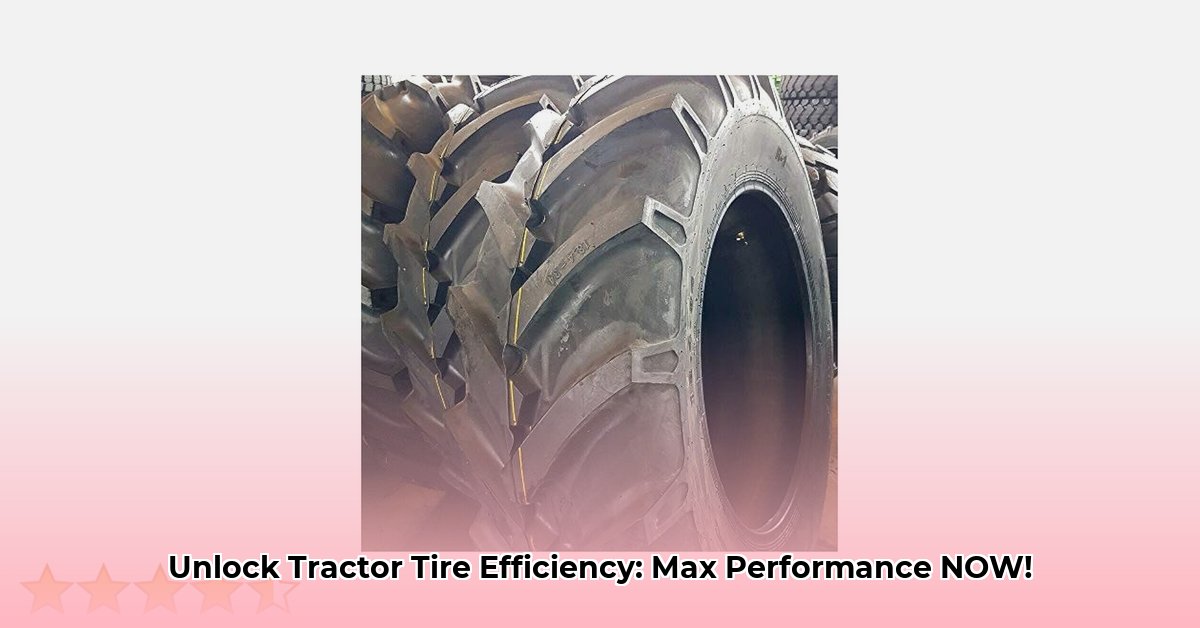
18.4 30 Tractor Tire Selection: Optimizing Farm Operations and Environmental Impact
Choosing the right 18.4-30 tractor tire is critical for farm efficiency and environmental sustainability. This guide provides actionable advice for farmers, manufacturers, researchers, and government agencies to improve tire performance and minimize environmental impact. We'll explore key features, maintenance, and the need for further research to optimize tire selection. For more information on smaller tractor tires, see this helpful resource: Lawn Tractor Tires.
Choosing the Right 18.4 30 Tractor Tire: A Tailored Approach
Before purchasing, carefully consider your farm's unique needs. Soil type (clay, sandy loam, etc.) significantly impacts tire selection. Heavier tractors and implements necessitate tires with higher load ratings. Prioritize fuel economy, tire life, or a balance based on your specific operational requirements. Selecting the wrong tire compromises efficiency and can cause damage.
"Choosing the right tire is not a one-size-fits-all proposition," explains Dr. Anya Sharma, Agricultural Engineer at Purdue University. "It's crucial to align tire specifications with your farm's unique conditions."
Key Features of 18.4 30 Tractor Tires: Understanding the Specifications
Consider factors like ply rating (indicating load capacity), tread depth and pattern (affecting traction and soil compaction), and construction (radial vs. bias-ply). A higher ply rating, such as a 12-ply tire, suggests increased durability and load-bearing capacity (up to 6400 lbs for some models). Deeper, more aggressive tread patterns generally enhance traction but may increase fuel consumption and soil compaction. Radial tires are often more fuel-efficient due to flexible sidewalls but may be more expensive initially. Manufacturers often advertise benefits like "deep aggressive tread" or "long bar tread designs". However, these claims generally lack independent verification.
How can we objectively compare the impact of tread patterns on fuel efficiency and soil compaction? More research is needed to quantify these claims through independent testing.
Fuel Efficiency, Soil Health, and Environmental Footprint: A Holistic Perspective
Current data comparing different 18.4-30 tractor tires regarding fuel consumption, soil compaction, and manufacturing/disposal impacts is limited. This knowledge gap hinders informed decision-making. Analyzing the entire tire lifecycle, from manufacturing to disposal, is crucial for understanding its environmental impact. Some argue current focus on performance neglects broader sustainability concerns.
“We need comprehensive, standardized testing to assess the full environmental impact of different tire types,” states Dr. David Miller, Soil Scientist at the University of California, Davis. “This includes evaluating manufacturing emissions and end-of-life management options.”
Actionable Steps for Optimizing 18.4 30 Tractor Tire Performance and Sustainability
This requires a collaborative effort:
Farmers: Regularly monitor tire pressure; consider tire pressure monitoring systems (TPMS) for optimal inflation. Adopt low-impact farming practices to minimize soil compaction.
Manufacturers: Increase transparency about tire materials and manufacturing processes; invest in research for sustainable materials and longer-lasting designs.
Researchers: Conduct independent comparative tests of tire designs; develop standardized testing protocols for reliable comparisons.
Government Agencies: Offer incentives for farmers adopting fuel-efficient technologies; fund research and support sustainable tire recycling programs.
Comparing Environmental Impact: A Detailed Look
Data on environmental impact comparison between different 18.4-30 tires is scant. However, we can examine tire construction, tread patterns, lifespan, and end-of-life management to better assess environmental performance.
Radial tires offer superior fuel efficiency but might have higher manufacturing impacts. Bias-ply tires may have lower manufacturing impacts but are less fuel-efficient. Tread patterns influence soil compaction—deep, aggressive patterns might cause more soil disturbance than wider, shallower ones. Tire lifespan impacts material consumption, and proper end-of-life management minimizes environmental harm. Currently, available information regarding tire recyclability and end-of-life processes lacks detail.
What steps can be taken to enhance the accessibility and quality of environmental data for tractor tires? Standardized testing protocols, manufacturer transparency, independent research, and supportive government policies are vital.
The Road Ahead: A Call for Collaboration
Addressing the knowledge gap on 18.4-30 tractor tire performance and sustainability demands collaboration. Farmers, manufacturers, researchers, and policymakers must work together to promote sustainable practices and informed decision-making for a healthier environment and more efficient agriculture. This includes creating standardized testing for environmental impact, promoting manufacturer transparency, funding independent research, and utilizing government incentive programs. Only through this holistic approach can we optimize tire selection for both performance and sustainability.